The Blockheads
The Blockheads are an English rock band formed in London in 1977. Originally fronted by lead singer Ian Dury as Ian Dury and the Blockheads or Ian and the Blockheads, the band has continued to perform since Dury's death in 2000. Current members include Derek "The Draw" Hussey (vocals), Chaz Jankel (guitar and keyboards), Norman Watt-Roy (bass), Mick Gallagher (keyboards and piano), John Turnbull (vocals and guitar). If Watt-Roy is unavailable, due to a conflict with Wilko Johnson dates (for whom he also plays bass), his duties are often covered by Nathan King. There is a rolling line-up of saxophonists that includes Gilad Atzmon, Terry Edwards or Dave Lewis and from time to time, the original sax player, Davey Payne.
The Blockheads | |
|---|---|
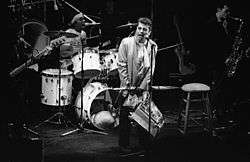 Left to right: Norman Watt-Roy (bass), Charley Charles (drums), Ian Dury (vocals) and Davey Payne (saxophone) | |
| Background information | |
| Also known as | Ian Dury and the Blockheads |
| Origin | London, England, United Kingdom |
| Genres | |
| Years active | 1977–present |
| Labels | |
| Associated acts | |
| Website | theblockheads |
| Members |
|
| Past members |
|
The band are best known for their hit singles, recorded with Dury, "What a Waste", "Hit Me with Your Rhythm Stick", "Reasons to be Cheerful, Part 3", and "Sex & Drugs & Rock & Roll".
History
Formation and early years

In 1974, Radio Caroline's Ronan O'Rahilly set up the pop group The Loving Awareness Band, comprising John Turnbull (guitar) and Mick Gallagher (keyboards) both formerly of 1960s psychedelic rock band Skip Bifferty with the session musicians Norman Watt-Roy (bass) and Charlie Charles (born Hugh Glenn Mortimer Charles, Guyana 1945) (drums). In 1976, The Loving Awareness Band released their only album, Loving Awareness (ML001), on O'Rahilly's label More Love Records. The album has appeared on CD more than once, although these reissues have been sourced from a mint vinyl pressing rather than from the original master tapes.
The Loving Awareness Band broke up in 1977 and Watt-Roy and Charles joined a new band being formed by Ian Dury, who had begun writing songs with pianist and guitarist Chaz Jankel (the brother of noted music video, TV, commercial and film director Annabel Jankel). With Jankel fashioning Dury's lyrics into number of songs, the two began recording with Charles, Watt-Roy, Gallagher, Turnbull and former Kilburn and the High Roads saxophonist Davey Payne. An album was recorded, but was of no interest to major record labels. Next door to Dury's manager's office, however, was the newly formed Stiff Records, a perfect home for Dury's maverick style.
The band was invited by Stiff to join the "Live Stiffs Tour", and the band Ian Dury and the Blockheads was born, with the name ostensibly taken from the song of the same name which portrayed a drunken Essex Untermensch stereotype:
They've got womanly breasts under pale mauve vests
Shoes like dead pigs' noses
Cornflake packet jacket, catalogue trousersA mouth what never closes
— from "Blockheads"
The tour, which also featured Elvis Costello and the Attractions, Nick Lowe, Wreckless Eric and Larry Wallis, was a great success, and Stiff launched a concerted Ian Dury marketing campaign.
Commercial success
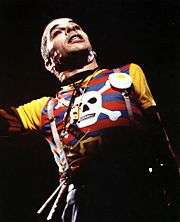
Under the management of Andrew King and Peter Jenner (the original managers of Pink Floyd) Ian Dury and the Blockheads quickly gained a reputation as one of the top live new wave music acts. Their first single, "Sex & Drugs & Rock & Roll", marked Dury's Stiff debut and although it was banned by the BBC it was named Single of the Week by NME on its release.[4] It was soon followed by the album New Boots and Panties!!, which was eventually to achieve platinum status. (Although it has been claimed that Dury coined the phrase "Sex & Drugs & Rock & Roll", there is evidence that it was already in common use and a very similar phrase had been used by Australian band Daddy Cool for the title of their 1972 second album Sex, Dope & Rock'n'Roll: Teenage Heaven.[5]) An parallel precursor is the longstanding and widely used phrase, wine, women and song. The tune is based on part of Charlie Haden's bass solo on "Ramblin'" on Ornette Coleman's 1959 album Change of the Century.
Dury and the band built up a dedicated following in the UK and other countries and scored several hit singles, including "What a Waste", "Hit Me with Your Rhythm Stick" (which was a UK number one at the beginning of 1979, selling just short of a million copies) and "Reasons to be Cheerful, Part 3" (number three in the UK in 1979).
The band's second album, Do It Yourself, was released in June 1979 in a Barney Bubbles-designed sleeve of which there were over a dozen variations, all based on samples from the Crown wallpaper catalogue. Bubbles also designed the Blockhead logo,[6] which received international acclaim and which continues to be used by the band as, for example, on their Live in Colchester 2004 DVD.
The hit single "Hit Me With Your Rhythm Stick" was notably not included, however, on the original release of the album. The single and its accompanying music video featured a Davey Payne sax solo with dual saxophones, in evident homage to jazz saxophonist Rahsaan Roland Kirk, who had made this his trademark technique.
Dury's lyrics are a distinctive combination of lyrical poetry, word play, observation of British everyday (working-class) life, acute character sketches, and vivid, earthy sexual humour. "This is what we find ... [H]ome improvement expert Harold Hill of Harold Hill, Of do-it-yourself dexterity and double-glazing skill, Came home to find another gentleman's kippers in the grill, So he sanded off his winkle with his Black & Decker drill." The song "Billericay Dickie" continues this sexual content, rhyming "I had a love affair with Nina, In the back of my Cortina" with "A seasoned-up hyena, Could not have been more obscener".
The Blockheads' sound drew from its members' diverse musical influences, which included jazz, rock and roll, funk, and reggae, and Dury's love of music hall.
Departure of Jankel
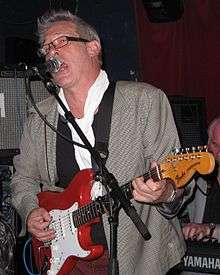
Jankel left the band temporarily and relocated to the U.S. after the release of "What A Waste" (his organ part on that single was overdubbed later) but he subsequently returned to the UK and began touring sporadically with the Blockheads, eventually returning to the group full-time for the recording of "Hit Me With Your Rhythm Stick"; according to Mick Gallagher, the band recorded 28 takes of the song but eventually settled on the second take for the single release. Partly due to personality clashes with Dury,[4] Jankel quit the group again in 1980, after the recording of the Do It Yourself LP, and he returned to the U.S. to concentrate on his solo career. The group worked solidly over the eighteen months between the release of "Rhythm Stick" and their next single, "Reasons to Be Cheerful", which returned them to the charts, making the UK Top 10. Jankel was replaced by former Dr. Feelgood guitarist Wilko Johnson, who also contributed to the next album Laughter and its two minor hit singles, although Gallagher recalls that the recording of the Laughter album was difficult and that Dury was drinking heavily in this period.[4] In 1980-81 Dury and Jankel teamed up again with Sly and Robbie and the Compass Point All Stars to record Lord Upminster. The Blockheads toured the U.K. and Europe throughout 1981, sometimes augmented by jazz legend Don Cherry on trumpet, ending the year with their only tour of Australia.[7]
The Blockheads disbanded in early 1982 after Dury secured a new recording deal with Polydor Records through A&R man Frank Neilson. Choosing to work with a group of young musicians which he named The Music Students, he recorded the album Four Thousand Weeks' Holiday. This album marked a departure from his usual style and was not as well received by fans for its American jazz influence.
Later years

The Blockheads briefly reformed in June 1987 to play a short tour of Japan and then disbanded again. In September 1990, following the death from cancer of drummer Charlie Charles, they reunited for two benefit concerts in aid of Charles' family, held at The Forum, Kentish Town, with Steven Monti on drums. In December 1990, augmented by Merlin Rhys-Jones on guitar and Will Parnell on percussion, they recorded the live album Warts & Audience at the Brixton Academy.[7]
The Blockheads (without Jankel, who returned to California) toured Spain in January 1991, then disbanded again until August 1994 when, following Jankel's return to England, they were invited to reform for the Madstock Festival in Finsbury Park; this was followed by sporadic gigs in Europe, Ireland, the UK and Japan through late 1994 and 1995.[7] In the early 1990s, Dury appeared with English band Curve on the benefit compilation album Peace Together. Dury and Curve singer Toni Halliday shared vocals on a cover of the Blockheads' track "What a Waste".
In March 1996, Dury was diagnosed with cancer. After his recovery from surgery, he set about writing another album. In late 1996 he reunited with the Blockheads to record the well-received Mr. Love Pants. Ian Dury and the Blockheads toured again, with Dylan Howe replacing Steven Monti on drums. Davey Payne left the group in August and was replaced by Gilad Atzmon. This amended line-up gigged throughout 1999 and performances culminated in their last performance with Dury on 6 February 2000 at the London Palladium. Dury died six weeks later on 27 March 2000.[7]
Present day
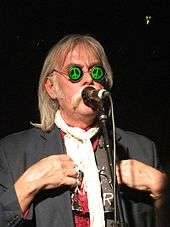
The Blockheads have continued after Dury's death, contributing to the 2001 tribute album Brand New Boots and Panties, then releasing Where's the Party (2004), Staring Down the Barrel (2009),[8] and the live album 30 Live At the Electric Ballroom (2008) to mark the 30th anniversary of New Boots and Panties!!.
The Blockheads still tour and currently consist of Jankel, Watt-Roy, Gallagher, Turnbull with John Roberts on drums, Gilad Atzmon or Dave Lewis on sax. Derek Hussey (aka "Derek The Draw", who was Dury's friend and minder[9]) is now writing songs with Jankel and sings lead vocals. 2013 was the band's 35th anniversary year.
On 23 November 2013 the band released the studio album Same Horse Different Jockey, thirty-five years to the day from when the band's first and only number one "Hit Me with Your Rhythm Stick" was released. The promotional video for the album, featuring the song "Greed", was directed and photographed by cinematographer Stuart Harris and included cameo appearances by Martin Freeman, Toby Jones and Rowland Rivron.[10]
In December 2014 the band performed a parody of "Reasons to Be Cheerful, Part 3" at the conclusion of Charlie Brooker's Charlie Brooker's 2014 Wipe on BBC Two.[11]
Currently there is a definitive documentary, Beyond the Call of Dury, in production by Free Seed Films focusing on the band members' individual careers as well as their involvement with Ian Dury. The documentary will highlight the countless number of studio sessions that each member has contributed to such as The Clash's London Calling, Roy Budd's Get Carter Soundtrack, Roger Daltrey's solo career, Nick Cave's Nocturama and Frankie Goes to Hollywood's "Relax" to name a few.
Notable hits
"Sex & Drugs & Rock & Roll"
The song was written by Dury and Jankel in Dury's flat in Oval Mansions, London (nicknamed "Catshit mansions" by Dury) that overlooked The Oval cricket-ground. Dury typically presented Jankel with his hand-typed lyric sheets. According to Chas in Sex And Drugs And Rock And Roll: The Life of Ian Dury, he would be repeatedly given the lyric for "Sex And Drugs And Rock And Roll" but kept rejecting the song only for it to be at the top of the pile in the next batch of songs, only to be rejected again. This went on until Dury sang the song's title in time with the intended guitar riff. Sometime later Jankel heard "Ramblin", a tune by Ornette Coleman (from the album Change of the Century, which also featured Charlie Haden and Don Cherry), and heard exactly the same bass riff being played by Haden.
Dury once apologised to Coleman for lifting the riff but, as Coleman explained, he (or possibly Haden) had lifted it himself from a Kentucky folk tune called "Old Joe Clark". An alternative version to this story exists: as Dury explained when he guested on BBC Radio 4's Desert Island Discs, he had apologised to Haden at Ronnie Scott's Club for the riff lift, who responded by saying there was no need for an apology as he himself had lifted it from an old Cajun tune.
The single did not chart, selling only around 19,000 copies (a small number for a single in 1977) but won critical acclaim. One factor of the poor sales performance may have been Stiff Records' singles deletion policy designed to promote initial sales and as such, chart success - the single was deleted after only two months.
Released, as it was, at the height of the popularity of punk rock, the song was misinterpreted (and often is to this day) as a song about excess, as its title and chorus might suggest. Although the single was banned by the BBC, a number of Radio 1 disc jockeys, including Annie Nightingale and John Peel, continued to promote the record by playing the mildly salacious B-side "Razzle In My Pocket". Dury himself maintained, however, that the song was not a punk anthem and said he was trying to suggest that there was more to life than a 9-to-5 existence (as in, for example, his track-by-track comments for the sleeve-notes of Repertoire Records' Reasons To Be Cheerful: The Best Of Ian Dury & The Blockheads compilation). The verse lyrics are at times somewhat inscrutable, although always suggestive of an alternative lifestyle:
Here's a little bit of advice, you're quite welcome, it is free
Don’t do nothing that is cut-price, you'll know what they'll make you be
They will try their tricky device, trap you with the ordinaryGet your teeth into a small slice, the cake of liberty
— from "Sex & Drugs & Rock & Roll"
The title of the song became part of the English language and was later used in many other song lyrics.

"Billericay Dickie"
Narrated by a bragging bricklayer from Billericay, the song is filled with name-checks for places in Essex and features a number of suggestive rhymes:
- I had a love affair with Nina
- In the back of my Cortina
- A seasoned-up hyena
- Could not have been more obscener
Each verse tells a different short story, relating one of Dickie's sexual conquests in southeastern England, while the choruses see him insisting he is a caring, conscientious lover and "not a thickie", even giving the names of two girls ("a pair of squeaky chickies") as referees who would attest to this. Dickie is a character most commonly referred to in the media as an "Essex lad". The song, perhaps the best example of Dury's "Englishness" or "Essexness", was given its fairground-like arrangement by American Steve Nugent.
Dury frequently stated (as, for example, in both his biographies Sex And Drugs And Rock And Roll: The Life Of Ian Dury and Ian Dury & The Blockheads: Song By Song) that he saw Dickie as a pathetic figure. He would reflect this on-stage by breaking down in the final part of the song, as if about to cry, before returning to shout the final lines. The song was rarely used as an opener for live sets ("Wake Up And Make Love With Me" commonly being used instead), but it does open the 1985 set recorded live at the Hammersmith Odeon that was released as the Hold Onto Your Structure VHS/DVD. Live versions can also be found on the two live albums Warts 'n' Audience and Straight from the Desk.
"What a Waste"
.jpg)
Essentially the song is about being in a job that makes you happy. Dury claimed, in a 1984 interview with Penthouse magazine that, while not condemning 9-to-5 jobs, he had written the song to make people question their lives, echoing the sentiments of his earlier single "Sex and Drugs and Rock and Roll". The song's verses list a number of occupations that the narrator could have taken, including driver, poet, teacher and soldier, even an inmate in a long-term institution and the ticket man at Fulham Broadway tube station. The chorus reveals that instead he chose to "play the fool in a six-piece band", highlighting some of its disadvantages, particularly loneliness, before deciding that "rock 'n' roll don't mind".
The song was written with Rod Melvin in mid-1975, two years before its eventual release. It was written following the break-up of Kilburn and the Highroads, and in a lull between the formation of Ian Dury & the Kilburns. Originally a third writing credit was given to Jankel, Dury's long-term songwriting companion, but this credit has gradually been phased out and the 2004 Edsel Records re-issue of Do it Yourself credits the song solely to Dury/Melvin. In the 2004 book Ian Dury & The Blockheads: Song By Song by Jim Drury and Phill Jupitus, however, guitarist John Turnbull claims that the middle instrumental section was brought over from one of the songs which four Blockhead members had written between them while in their previous band Loving Awareness.
The song, Dury's first hit, was released in April 1978, just before the start of a headlining tour, entering the Top 75 on 29 April and spending 12 weeks there. It peaked at No. 9 in the UK Single Charts, becoming Stiff Records' biggest-selling single. A very limited 12" pressing was also released. Although the song is seen as specifically a Blockheads song, the B-side, "Wake Up and Make Love with Me", was taken from Dury's New Boots and Panties!! album.
"Hit Me with Your Rhythm Stick"
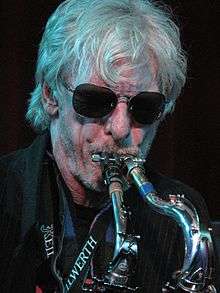
First released as the Stiff Records 7" single BUY 38, "Hit Me With Your Rhythm Stick"/"There Ain't Half Been Some Clever Bastards" was Number One in the UK Singles Chart in January 1979 and is the band's most successful single.[12] It also was named the best single of 1979 in the Pazz & Jop poll.
Its lyrics mix various locations across the world and a number of phrases in non-English languages (including French and German). According to Dury the song has an anti-violence message.
"Reasons to be Cheerful, Part 3"
Released on 20 July 1979, the single "Reasons to be Cheerful, Part 3"/"Common as Muck" reached No. 3 in the UK Singles Chart the following month. It was the last single to be released by the band with their original line-up.
Discography
- New Boots and Panties!! (1977)
- Do It Yourself (1979)
- Laughter (1980)
- Live! Warts 'n' Audience (1990)
- The Bus Driver's Prayer and other Stories (1994)
- Mr. Love Pants (1997)
- Straight from the Desk (2001)
- Ten More Turnips from the Tip (2002)
- Where's the Party? (2004)[13]
- 30 – Live at The Electric Ballroom (2008)
- Staring Down the Barrel (2009)
- Same Horse Different Jockey (2013)
- Beyond the Call of Dury (2017)
References
- "How The Blockheads are keeping the spirit of Ian Dury alive". Theargus.co.uk. Retrieved 26 December 2018.
- Scheerhout, John (12 September 2016). "Review: The Blockheads at Band On The Wall, Manchester". Manchestereveningnews.co.uk. Retrieved 26 December 2018.
- "The Quietus - Film - Film Features - The Blockheads On Ian Dury Biopic Sex & Drugs & Rock & Roll". Thequietus.com. Retrieved 26 December 2018.
- Technical Direct (UK) Ltd. "Mickey Gallagher interview, October 2008". Demon Music Group. Archived from the original on 15 October 2009. Retrieved 30 December 2009.
- "Daddy Cool official website". Daddy Cool. Retrieved 30 December 2009.
- "Barney Bubbles obituary". Aural-innovations.com. Retrieved 29 January 2009.
- "Blockheads official website". Theblockheads.com. Archived from the original on 9 May 2008. Retrieved 30 December 2009.
- "The Blockheads - Staring Down The Barrel". YouTube. 4 June 2009. Retrieved 30 March 2013.
- "Derek The Draw". Anduryauthor.wordpress.com. Retrieved 30 March 2013.
- "The Blockheads". Theblockheads.com. Retrieved 19 November 2015.
- Jones, Ellen E. "Charlie Brooker's 2014 Wipe - review: Comedian takes satirical swipes at Nigel Farage among others". The Independent. Retrieved 19 November 2015.
- "Official UK Top 100 Selling Singles: TOP 40". Vibewaves.brinkstar.net. Archived from the original on 15 April 2010.
- "Music - Review of The Blockheads - Where's The Party?". BBC. Retrieved 19 November 2015.